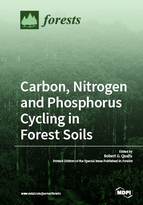Carbon, Nitrogen and Phosphorus Cycling in Forest Soils
A special issue of Forests (ISSN 1999-4907). This special issue belongs to the section "Forest Ecology and Management".
Deadline for manuscript submissions: closed (31 March 2018) | Viewed by 69833
Special Issue Editor
Interests: forest biogeochemistry; wetland biogeochemistry; succession and ecosystem development; effects of climatic warming and CO2 fertilization on forest soils; soil organic matter chemistry; microbial ecology; chlorine chemistry in water; ultraviolet light disinfection
Special Issues, Collections and Topics in MDPI journals
Special Issue Information
Dear Colleagues,
The majority of carbon stored in the soils of the world is stored in forests. The refractory nature of some portions of forest soil organic matter also provides the slow, gradual release of organic nitrogen and phosphorus to sustain long term forest productivity. Contemporary and future disturbances, such as climatic warming, deforestation, short rotation sylviculture, the invasion of exotic species, and fire, all place strains on the integrity of this homeostatic system of C, N, and P cycling. On the other hand, the CO2 fertilization effect may partially offset losses of soil organic matter, but many have questioned the ability of N and P stocks to sustain the CO2 fertilization effect.
Despite many advances in the understanding of C, N, and P cycling in forest soils, many questions remain. For example, no complete inventory of the myriad structural formulae of soil organic N and P has ever been made. The factors that cause the resistance of soil organic matter to mineralization are still hotly debated. Is it possible to “engineer” forest soil organic matter so that it sequesters even more C? The role of microbial species diversity in forest C, N, and P cycling is poorly understood. The difficulty in measuring the contribution of roots to soil organic C, N, and P makes its contribution uncertain. Finally, global differences in climate, soils, and species make the extrapolation of any one important study difficult to extrapolate to forest soils worldwide.
We invite submissions for a Special Issue of Forests on the subject of “Carbon, Nitrogen and Phosphorus Cycling in Forest Soils”. Topics for submissions may include:
- forest soil C stocks and climate change,
- ability of soil N and P mineralization to sustain increased productivity due to CO2 fertilization,
- causes of recalcitrance in soil organic matter mineralization,
- contribution of roots to soil C and N,
- methane production and oxidation in forest soils,
- soil C,N, and P during forest succession,
- effects of invasive species, forest management practices, or fire on C,N, and P cycling,
- roles of microbes and soil fauna on C, N, and P cycling,
- stable isotope studies of C and N cycling,
- or new methods for study of C, N, and P cycling.
Prof. Dr. Robert G. Qualls
Guest Editor
Manuscript Submission Information
Manuscripts should be submitted online at www.mdpi.com by registering and logging in to this website. Once you are registered, click here to go to the submission form. Manuscripts can be submitted until the deadline. All submissions that pass pre-check are peer-reviewed. Accepted papers will be published continuously in the journal (as soon as accepted) and will be listed together on the special issue website. Research articles, review articles as well as short communications are invited. For planned papers, a title and short abstract (about 100 words) can be sent to the Editorial Office for announcement on this website.
Submitted manuscripts should not have been published previously, nor be under consideration for publication elsewhere (except conference proceedings papers). All manuscripts are thoroughly refereed through a single-blind peer-review process. A guide for authors and other relevant information for submission of manuscripts is available on the Instructions for Authors page. Forests is an international peer-reviewed open access monthly journal published by MDPI.
Please visit the Instructions for Authors page before submitting a manuscript. The Article Processing Charge (APC) for publication in this open access journal is 2600 CHF (Swiss Francs). Submitted papers should be well formatted and use good English. Authors may use MDPI's English editing service prior to publication or during author revisions.
Keywords
- carbon cycle
- nitrogen cycle
- phosphorus cycle
- forest soil
- biogeochemistry
- climate change






